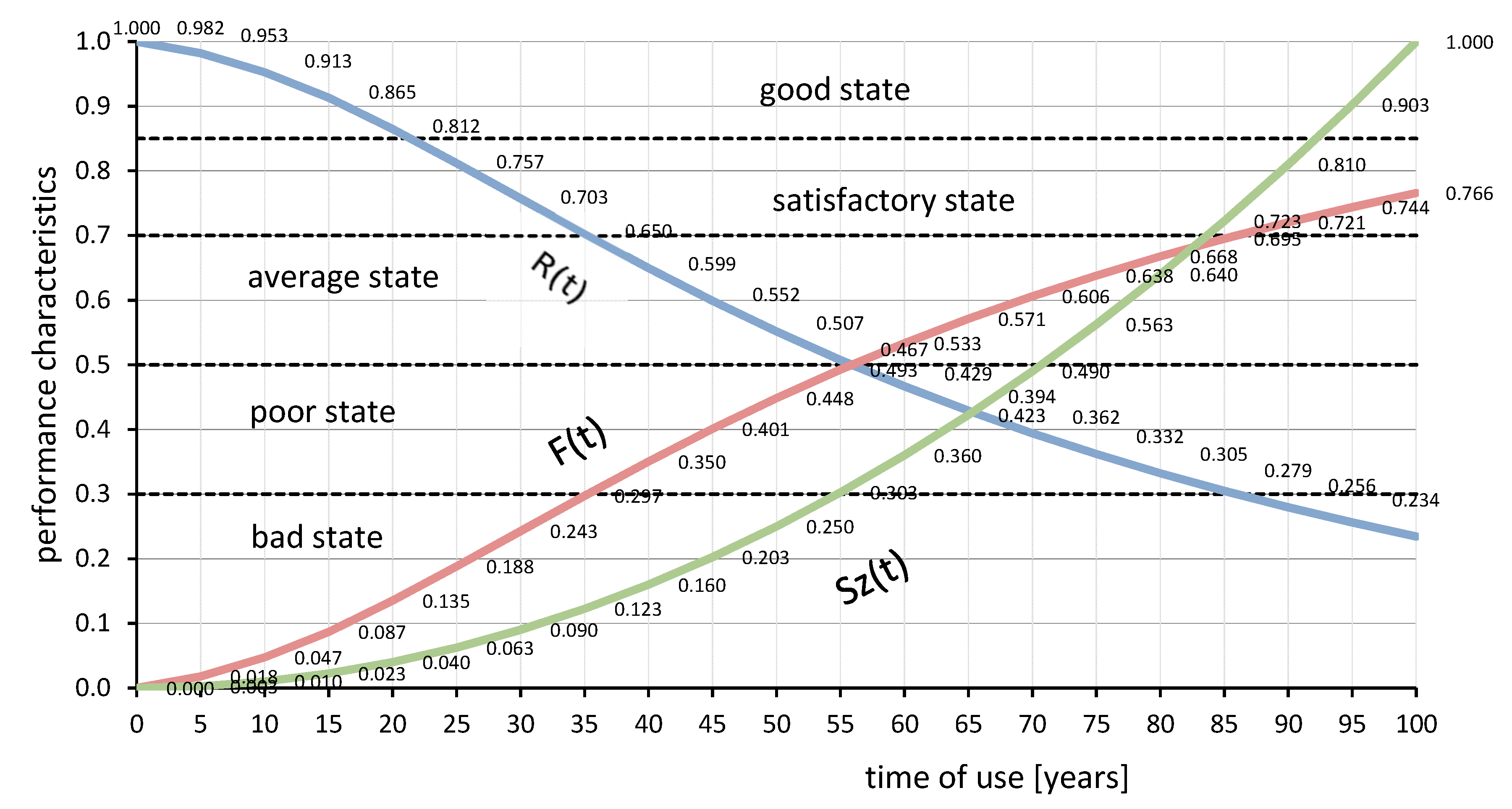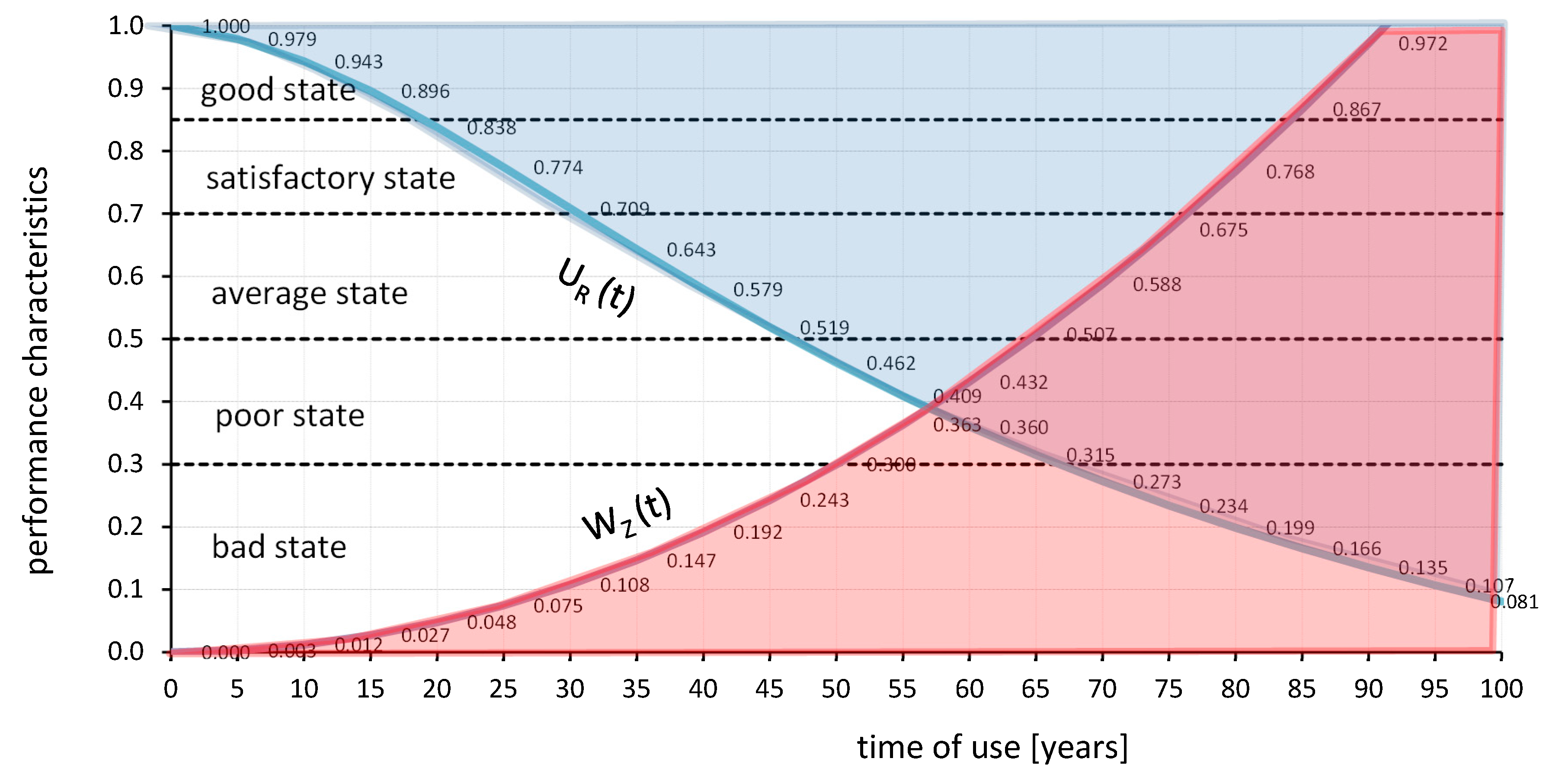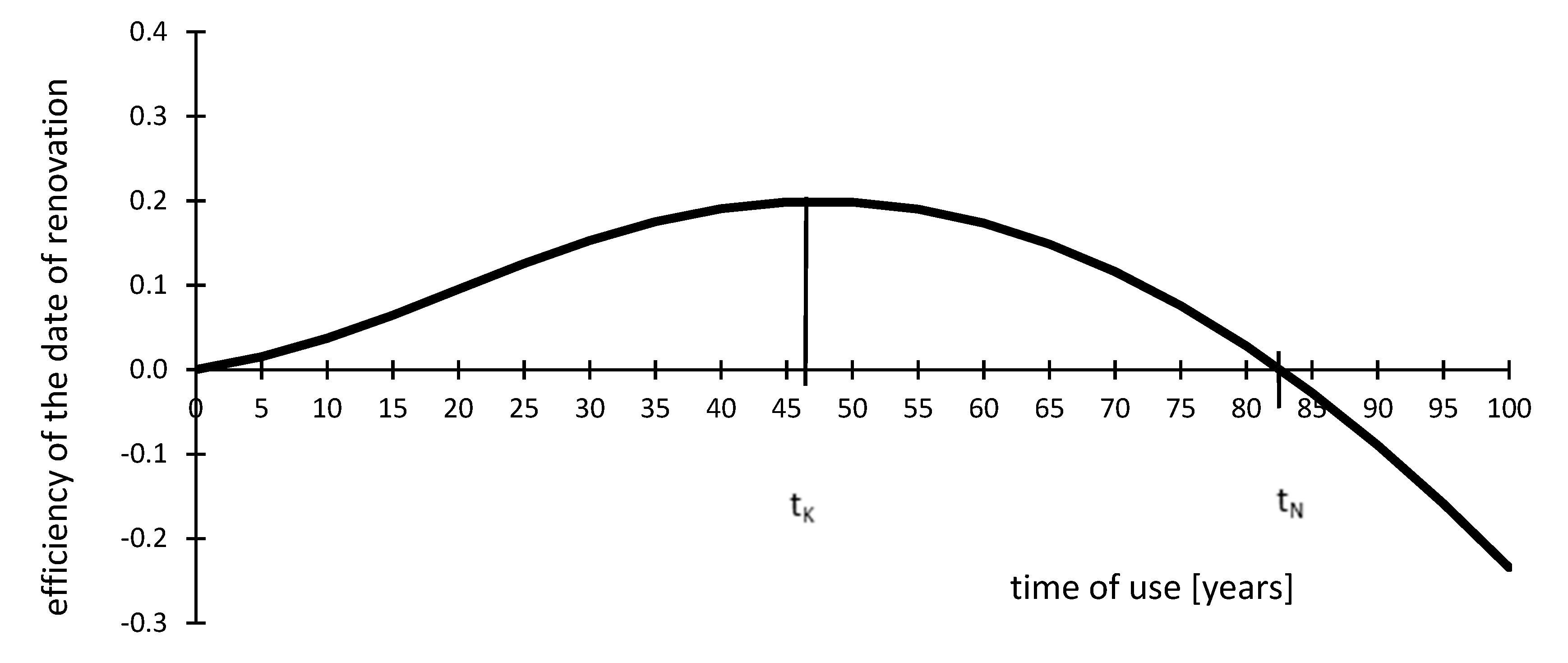1. Introduction
The technical wear of a building changes as a result of the aging process. Along with the passing of time, a decrease in the performance characteristics of a building [
1,
2] takes place, and their total or partial restoration is only possible as a result of repair works [
3,
4,
5,
6,
7].
The date of complete renovation in the case of a non-renovated building ought to be planned in accordance with the guidelines of rational management [
8,
9,
10,
11,
12]. This date should result from the principle of the lowest costs of achieving the aim, which is maintaining the technical condition of the building at an adequate level. Earlier renovation restoring the technical condition of a building leads to limiting further wear, which results in lower total costs of repairs. Repair works pushed back to further years of use lead to significant deterioration of the technical conditions, and, at the same time, increased costs of repair.
Making decisions connected with the choice of the scope, type and date of repairs on buildings is very problematic for managers. The problem of the current assessment of the technical conditions is a subject of many studies. However, in addition to assessing the technical conditions, algorithms supporting decision-making regarding repair works are also necessary. The paper [
13] discusses a technical and economic analysis that compares three proactive strategies (preventive, predictive, and improvement) for two types of coatings typically used in maintenance interventions of facades of social housing units in Lisbon: Emulsion, and elastomeric coatings. Bucoń and Sobotka [
1] propose a decision model of the choice of the scope of repairs based on three assessments of a building: The technical, energy, and functional condition. The synthetic indicator of the use value of a building obtained from the assessments is the basis for selecting a renovation solution which allows the highest increase in use value in relation to the amount of financial resources engaged to be obtained. The optimal selection of proposed interventions across the broad spectrum of assets is also problematic, and currently, it is performed in a subjective manner. The paper [
14] identifies a number of prioritization techniques that can be used to compare and rank repair and renewal projects.
The subject matter connected with developing methods of analyzing the costs of the life cycle of technical objects (life cycle cost analysis) is becoming increasingly popular [
15,
16]. More and more frequently, attempts are made to develop tools aiding the indication of economically validated directions of actions pertaining to the management of the life cycle of building structures [
10,
11,
12]. Reference [
17] presents the BdMS (building management systems) model of managing a building, based on predicting the durability of building components on the basis of deterministic and stochastic methods. In reference [
18], the optimization method is described, which is based on minimizing the expected total cost of the life cycle of a building while maintaining acceptable reliability of its structure over the entire course of its use. Analyses connected with the relationship of the cost of the life cycle and time also occur in many other models pertaining to various building structures [
19,
20,
21]. The paper [
22] discusses a set of 17 criteria to help the maintenance choice for building facades, from three viewpoints: Physical performance, risk, and costs.
Risk and uncertainty are typical for the cost calculation of a life cycle and require an effective system of managing risk to constitute an integral part of the life cycle cost analysis [
23,
24]. Reference [
25] contains a model of estimating the costs of the life cycle and the entire cost of the life of a building, which makes it possible to quantify the increase in costs resulting from the carried and assessed risk. The model makes use of Mamdani fuzzy inference.
In references [
26,
27], a stochastic and multi-task system of aiding decision-making was proposed in an effort to optimize management of roof maintenance, both at the level of planned renovation works, as well as at the design stage. The discrete Markov chain was used to predict the effectiveness of the roof system over the time of its use.
Another method of budgeting the costs of maintenance and renovation is Schroeder’s method [
28]. This method is based on determining the technical state of various building components in the function of time.
In reference [
29] a new stochastic dynamic programming model is proposed where optimality conditions are derived through the Hamilton–Jacobi–Bellman equations. The model defined the joint production and repair, major maintenance switching strategies minimizing the total cost over an infinite planning horizon. Two probabilistic approaches are described in [
30], one approach using a mathematical function (Weibull) to describe the performance of a component over time and one approach using discrete Markov chains.
In reference [
31] a method combines the use of failure mode and effect analysis was proposed to permit identifying likely failure modes from which maintenance actions could be planned and the limit states method to assess the durability of the given retrofit action. The purpose of the research reported in reference [
32] was to develop a model that allows for the identification of the owner’s needs in all phases of the building life cycle. A six-level classification system for the information required in the project and a two-dimensional model that maps the life cycle were corroborated and improved by applying the Delphi technique to a panel of ten experts in two rounds. Reference [
33] concluded that the planning and the application of the condition-based maintenance strategy have significant characteristics and make reference to the resulting prediction model.
The authors of this article suggest another approach to the cost analysis of renovation works necessary to maintain a building at a given level of performance characteristics. The proposed model allows for estimating the costs of renovation and repair works on a building at a given stage of its use with the value of the technical wear of the building in the same time period. It would seem that the consumption values and the cost of renovation works are at a similar level. However, it turns out that the cost of restoring the building’s performance differs from the value of the building’s consumption. The proposed method takes into account the change of performance over time. With this action plan repair, it is possible at any given moment of time.
Estimating the cost of renovation work is a very important problem. The existing methods are based on working ad hoc. The proposed method takes into account changes in performance and degree of technical wear over time.
2. Main Objectives of the Proposed Method
It is the task of real estate managers or owners to maintain the building in a non-deteriorating technical and functional condition. In order to preserve the technical and functional condition of a building at an adequate level, methodological support of decision-making processes pertaining to carrying out rational maintenance management is necessary. The purpose of the research is a proposal of a model allowing for the estimation assessment of the costs of renovation and repair works on a building at a given stage of its use, and their relationship with the value of technical wear of a building in the same time period. Residential buildings constructed in traditional technology were subjected to analysis.
In the carried out analysis, temporal methods applied for calculating the level of technical wear were applied, with the PRRD [
2] (prediction of reliability according to Rayleigh distribution) model of changes in the performance characteristics was applied to determine the costs of renovation works necessary for returning performance characteristics to the building.
The research consisted in determining the value of the technical wear of the building in good, satisfactory, average, and poor technical condition. The value of technical wear of each of the examined buildings resulting from the degree of wear was compared with the cost of restoring the functional properties of the building to their original state.
3. Functions Describing the Aging Process of a Building
In accordance with the recommendations specified by standards [
34,
35,
36], determining the changes in the performance characteristics of a building requires the application of PSLDC (predicted service life of components) risk curves as tools aiding the planning of renovation deadlines resulting from these recommendations. Models of predicting changes in the performance characteristics of building components, as well as the entire building, were proposed [
2,
37]. Methods of non-linear aging processes of the entire building accounting for the role and weight of individual building components were developed. The PRRD (prediction of reliability according to Rayleigh distribution) [
2,
37,
38] allows for the prospective assessment of the technical conditions of a building. The developed models of predicting the aging process of residential buildings constructed using traditional technology, as well as its components, account for Weibull distribution as a distribution of the reliability over the time a building structure is in service.
The aging process of a building can be described by the following functions of the PRRD model: Function of changes in the performance characteristics of a building R(t), function of changes failure of a building F(t) as well as the function of building wear SZ(t).
A building comprises many components. For an individual i-th element, the functions of the aging process are described by three relationships:
where:
Technical wear is defined as the loss of service, functional or technological capabilities of an object or its components [
6,
7]. Wear is described by the function of time as well as the effect of external factors. A numerical parameter describing the technical condition of a building or its components is the level of wear expressed in percentages. Among methods of describing the level of wear are temporal, visual, and weighted average methods.
In the proposed method, the level of wear, was described in a different manner, on the basis of the intensity of damage. However, eventually, after appropriate transformation formulas, we obtain the same pattern as in the method of the time.
where the intensity of damage λ(t) is the rate of deterioration of performance characteristics:
Each building is made up of many components. These elements serve various functions, are created from dissimilar construction materials, each is characterized by different properties and different service lives. Functions of the aging process for the entire building, accounting for weights Ai of components are described by the relationships:
where:
The proposed PRRD method of predicting the aging process of buildings allows for a description of the changes in the technical wear, assessing the rate at which a building ages, a description of the aging process of a building, predicting changes in the performance characteristics of a renovated building for any given cycle between repairs and an analysis of the consequences of the lack of repairs in a building.
4. Building Constructed Using Traditional Technology—Case Study
The method was applied for a building with chosen material and construction solutions. The building subjected to analysis was built using traditional technology.
The research included 592 residential buildings located within the municipality of Zielona Góra. All buildings are two-story, founded on a rectangular plan, almost all frontages of houses overlook the streets. The buildings were built between 1915–2015. The administrator of all the analyzed buildings is the Department of Municipal and Housing Administration in Zielona Góra.
All the buildings of the collected research material have similar material and structural solutions. The walls of the analyzed objects are made of full brick on cement-lime mortar, the ceilings—wooden beam, stairs and roof truss—wooden, roof cover—ceramic tiles. The differences are only in the spans of floors, numbers of floors and roof truss constructions (usually purlin-tick, sometimes collar beam). For all the buildings, a periodic assessment of technical condition was carried out by experts. During the evaluation, the consumption rates of individual elements of buildings were established.
Each building was divided into 25 components. Components serving a structural function have the most significant influence on the service life. Other supporting elements influence the performance characteristics of the building to a lesser degree. When indicating the performance characteristics for the entire building, which is a collection of components, the intensity of the influence of performance characteristics of components was accounted for in the form of a scale of weights of A components. In determining functions (6), (7), and (8): Changes in the performance characteristics of the entire building RA(t), functions of changes in building unreliability F(t), as well as functions of changes in the technical wear of a building S(t), relationships (1), (2), and (3) determining changes in 25 building components were used. The course of functions describing the aging process of the entire building has been illustrated in
Figure 1.
5. Value of Technical Wear and the Decrease in Performance Characteristics
The level of wear is a measure of the technical condition of a building. With the passing of time, the level of wear in continuously increasing in non-renovated buildings. Value of technical wear W
Z(t) signifies the cost k
P recreating the level of wear:
The performance characteristics R(t) of a building decrease over the course of its use. Restoring the performance characteristics to their maximal value 1.0 may be possible only as a result of carrying out renovation.
The value of loss of performance characteristics U
R(t) signifies the cost k
U of restoring performance characteristics. Changes in the performance characteristics of a building over the course of its use expressed by cost are the loss of use values.
Figure 2 presents the values of the technical wear (red field) as well as values of loss in performance characteristics (blue field) for subsequent years that a building with a normative service life of T = 100 years is in service.
The difference between the values of the technical wear W
Z(t) and the value of the decrease in the performance characteristics U
R(t) determines how much higher the costs of renovation are from the value of building wear:
The optimization task comes down to seeking the aim function, which is the extreme of the function that is the efficiency of the renovation date E
R(t):
Figure 3 shows a graph of the function of the efficiency of the date of renovation. The date at which function K(t) reaches the maximum value is the most cost-effective for renovation. The derivative of the function is equal to zero. The date t
K is the period when it is most worth carrying out complete renovation.
After the period tK, both the costs of restoring performance characteristics as well as the values of technical wear of a building are high. With the lack of renovation works, the building undergoes degradation, with the costs of renovation works continuously increasing. The deadline for carrying out renovation works is the period tN, after which renovation is not economically efficient.
For the examined example, a non-renovated building made in traditional technology, it turned out that after 47 years, both the costs of restoring performance and the value of technical wear are high. Renovation is economically unprofitable if the building has not been renovated for 82 years.
Negative values of the K(t) function indicate the fact that long-term lack of renovation works is the reason behind high wear and, at the same time, low performance characteristics. Negative values of the K(t) signify the necessity of demolishing the building due to the unprofitability of renovation.
6. Conclusions
The basic task over the course of maintaining a building is the prospective planning of renovation works and predicting the resources necessary for their execution. The dates of renovation works ought to be planned in accordance with the guidelines of rational management. The proposed method may be helpful when planning renovation works on buildings.
The proposed model allows for the proper estimation of the costs of renovation and repair works and their relationship with the value of the technical wear of a building at each period of its use. Residential buildings constructed using traditional technologies were subjected to analysis. In the carried out analysis, the PRRD (prediction of reliability according to Rayleigh distribution) model of changes in the performance characteristics was applied.
The conclusions resulting from the conducted analysis are the basis for further research on the costs of restoring performance. The value of technical wear signifies the cost recreating the level of wear. Changes in the performance characteristics of a building over the course of its use expressed by cost are the loss of performance characteristics. It might seem that the consumption values and the cost of renovation works are at a similar level, but in practice, it turns out that the cost of restoring the functional properties of the building is different from the value of the building’s consumption. And this is the essence of the problem presented.
Anticipating the aging process is essential when maintaining a residential building. However, the problem remains unrecognized in many respects. No data indicate the need for research and analysis related to this topic. Building degradation curves are just the beginning of the research. Forecasting damage to a building can be developed and predicting changes in operating costs over the entire life cycle of a building requires many simplifications. Further research will cover the subject of LCA, the impact of renovation works on the environment. It will also analyze changes in prices of building materials and renovation works over time in Poland and in other countries.








